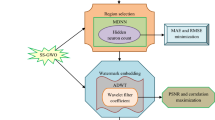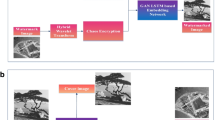Abstract
Due to the rapid growth of multimedia in network technology, accessing the digital media becomes very easy. Hence, protecting the intellectual property requires more interest in image watermarking. For this sake, different image watermarking approaches are developed, but it poses robustness and transparency issues. Therefore, an effective image watermarking method named Water Chaotic fruit fly Optimization algorithm-based Deep Convolutional neural network (WCFOA-based Deep CNN) is developed for embedding the secret message to the cover media. The proposed WCFOA is developed by integrating the Water Wave Optimization (WWO) with the Chaotic Fruit Fly Optimization algorithm (CFOA). The inspiration of propagation operator and the refraction operator increases the diversity of population and minimizes the premature convergence. However, the breaking, propagation and the refraction operator of the proposed optimization shows the effectiveness of balance between the exploitation of exploration phase in search space using the fitness measure. Accordingly, the embedding process is achieved using the wavelet transform with the selected optimal region using the evaluated fitness value. Several images of brain tumors from BRATS dataset, with tumors having different contrast and form, are used to assess the proposed method. The experimental analysis shows that, the proposed WCFOA-based Deep CNN obtained better performance using the metrics, like correlation coefficient and Peak signal-to-noise ratio (PSNR) with the values of 1 and 45.2157 using without noise scenario and the correlation coefficient and PSNR of 0.9918 and 45.0627 for Impulse noise. By considering the salt and pepper noise, the correlation coefficient and PSNR is 0.9918 and 47.001 and in the Gaussian noise scenario the values of correlation coefficient and PSNR is 0.990 and 46.985, respectively.













Similar content being viewed by others

References
Abraham J, Paul V (2019) An imperceptible spatial domain color image watermarking scheme. J King Saud Univ-Comput Inform Sci 31(1):125–133
Arora M, Khurana M (2020) Secure image encryption technique based on jigsaw transform and chaotic scrambling using digital image watermarking. Opt Quant Electron 52(2):59
Bagheri M, Mohrekesh M, Karimi N, Samavi S (2020) Adaptive control of embedding strength for image watermarking using neural networks
BRATS 2018 Dataset, “https://www.med.upenn.edu/sbia/brats2018.html”, accessed on April 2020.
Dharwadkar NV, Amberker BB (2010) An Efficient Non-blind Watermarking Scheme for Color Images using Discrete Wavelet Transformation. Int J Comput Appl 2(3):60–66
Dharwadkar NV, Amberker BB (2010) Watermarking scheme for color images using wavelet transform based texture properties and secret sharing. Int J Inform Commun Eng 6(2):93–100
Dharwadkar NV, Amberker BB, Gorai A (2011) Non-blind watermarking scheme for color images in RGB space using DWT-SVD. In: Proceedings of IEEE international conference on communications and signal processing. NIT, Calicut, India, pp 489–493
Ernawan F, Kabir MN (2018) A robust image watermarking technique with an optimal DCT-psycho visual threshold. IEEE Access 6:20464–20480
Ernawan F, Kabir MN (2020) A block-based RDWT-SVD image watermarking method using human visual system characteristics. Vis Comput 36(1):19–37
Fengbin T, Yin S, Ouyang P, Tang S, Liu L, Wei S (2017) Deep convolutional neural network architecture with reconfigurable computation patterns. IEEE Trans Very Large Scale Integration (VLSI) Syst 25(8):2220–2223
Gao Y, Wang J, Shi Y-Q (2019) Dynamic multi-watermarking and detecting in DWT domain. J Real-Time Image Proc 16(3):565–576
Holzinger A, Langs G, Denk H, Zatloukal K, Miller H (2019) Causability and explanability of artificial intelligence in medicine. WIREs Data Mining Knowl Discov 9:e1312. https://doi.org/10.1002/widm.1312S
Hsu C-S, Shu-Fen T (2010) Probability-based tampering detection scheme for digital images. Opt Commun 283:1737–1743
Hsu C-S, Shu-Fen T (2019) Enhancing the robustness of image watermarking against cropping attacks with dual watermarks. Multimed Tools Appl:1–27
Jiao S, Zhou C, Shi Y, Zou W, Li X (2019) Review on optical image hiding and watermarking techniques. Opt Laser Technol 109:370–380
Kaur M, Jindal S, Behal S (2012) A study of digital image watermarking. J Res Eng Appl Sci 2(2):126–136
Kumar C, Singh AK, Kumar P, Singh R, Singh S (2020) SPIHT-based multiple image watermarking in NSCT domain. Concurr Comput: Pract Exper 32(1):e4912
Lei X, Du M, Xu J, Tan Y (2014) Chaotic fruit fly optimization algorithm. Int Conf Swarm Intell, Springer, Cham:74–85
Liao X, Li K, Zhu X, Ray Liu KJ (2020) Robust detection of image operator chain with two-stream convolutional neural network. IEEE J Selected Topics Signal Process 14(5):955–968. https://doi.org/10.1109/JSTSP.2020.3002391
Liao X, Yu Y, Li B, Li Z, Qin Z (2020) A new payload partition strategy in color image steganography. in IEEE Trans Circ Syst Video Technol 30(3):685–696. https://doi.org/10.1109/TCSVT.2019.2896270
Ma B, Chang L, Wang C, Li J, Wang X, Shi YQ (2020) Robust image watermarking using invariant accurate polar harmonic Fourier moments and chaotic mapping. Signal Process:107544
Mairgiotis A, Kondi LP, Yang Y (2017) DCT/DWT blind multiplicative watermarking through student distribution. Proceed IEEE Int Conf Image Process (ICIP):520–524
Makbol NM, Khoo BE (2013) Robust blind image watermarking scheme based on redundant discrete wavelet transform and singular value decomposition. AEU-Int J Electron Commun 67(2):102–112
Rouhani BD, Chen H, Koushanfar F (2018) DeepSigns: a generic watermarking framework for protecting the ownership of deep learning models.
Roy A, Maiti AK, Ghosh K (2018) An HVS inspired robust non-blind watermarking scheme in YCbCr color space. Int J Image Graph 18(3):23
Sadeghi M, Toosi R, Akhaee MA (2019) Blind gain invariant image watermarking using random projection approach. Signal Process 163:213–224
Savakar DG, Ghuli A (2019) Robust invisible digital image watermarking using hybrid scheme. Arab J Sci Eng 44(4):3995–4008
Sharma V, Mir RN (2019) An enhanced time efficient technique for image watermarking using ant colony optimization and light gradient boosting algorithm. J King Saud Univ-Comput Inform Sci
Singh AK (March 2017) Improved hybrid algorithm for robust and imperceptible multiple watermarking using digital images. Multimed Tools Appl 76(6):8881–8900
Singh A, Dutta MK (2017) A robust zero-watermarking scheme for tele-ophthalmological applications. J King Saud Univ-Compu Inform Sci
Wang J, Zhiguo D (2019) A method of processing color image watermarking based on the Haar wavelet. J Vis Commun Image Represent 64:102627
Zhang L, Wei D (2020) Image watermarking based on matrix decomposition and gyrator transform in invariant integer wavelet domain. Signal Process 169:107421
Zheng Y-J (2015) Water wave optimization: a new nature-inspired metaheuristic. Comput Oper Res 55:1–11
Author information
Authors and Affiliations
Corresponding author
Additional information
Publisher’s note
Springer Nature remains neutral with regard to jurisdictional claims in published maps and institutional affiliations.
Rights and permissions
About this article
Cite this article
Ingaleshwar, S., Dharwadkar, N.V. & D., J. Water chaotic fruit fly optimization-based deep convolutional neural network for image watermarking using wavelet transform. Multimed Tools Appl 82, 21957–21981 (2023). https://doi.org/10.1007/s11042-020-10498-0
Received:
Revised:
Accepted:
Published:
Issue Date:
DOI: https://doi.org/10.1007/s11042-020-10498-0



